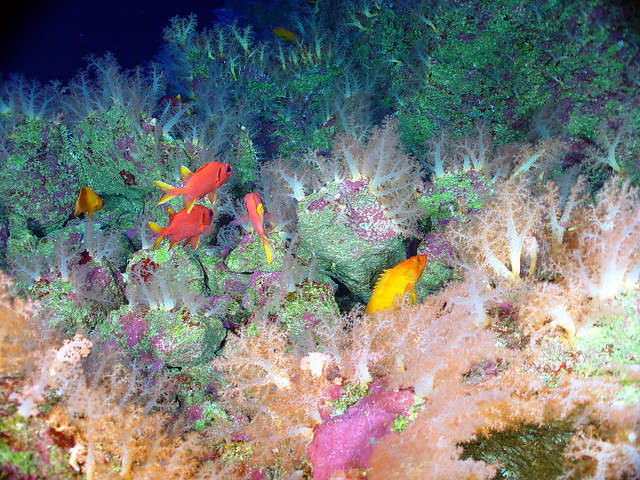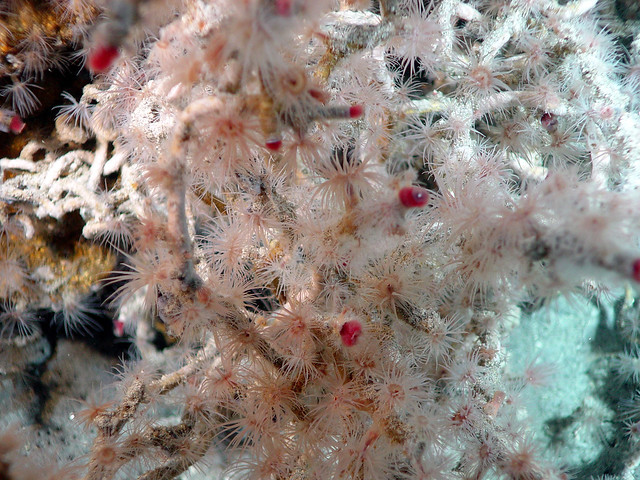 |
| A degassing event at Brimstone Pit A degassing event at Brimstone Pit at NW Rota-1 volcano releases an extraordinary number of bubbles, probably carbon dioxide. The yellow parts of the plume (seen here in the background) contain tiny droplets of molten sulfur. Image courtesy of NOAA Submarine Ring of Fire 2006 (Volcanoes Unit MTMNM) Taken on April 27, 2006 CC BY-NC 2.0 https://flic.kr/p/bD1Pht |
National Monuments in Danger
We are down to the FINAL HOURS of the comment period! Please, take the time today to comment on the fate of this national monument, any of the other 27 monuments on the Interior Department's list, or on the fate of all of them.
To comment on the monument review process (due July 10, 2017):
Okay, really? Our country is looking at getting rid of the Marianas Trench Marine National Monument? This is just insane!
I mean, come on, it's the lowest point on the Earth. It's the opposite of Mt. Everest! And it's in United States' territory. Not protecting this site is an insult to the world.
From the NOAA website
The Mariana Trench is the "Grand Canyon" of the ocean (actually 120 times larger), including some of the deepest known areas on earth. The region is geologically very complex, including a subduction zone, back arc basins, and active simmering island and submarine volcanoes. The active volcanoes and thermal vents support life under some of the harshest conditions on the planet. Maug Crater represents one of only a few places on Earth where photosynthetic and chemosynthetic communities of life are known to coexist. The waters of the archipelago's northern islands are also among the most biologically diverse in the Western Pacific. The greatest diversity of seamount and hydrothermal vent life yet discovered was found in the Marianas Trench.
For me, this post is a bit of a milestone. I made it to the goal of posting at least once on every one of the 27 monuments in danger. Of course, I wish I could have done much more, written much more about each of these places, and I am sure that I will have the opportunity to do so next week, too.
Even after the comments period closes, we can still be active, writing our politicians and other stakeholders to continue the fight.
Because I fear that, regardless of the incredibly positive input received by the Department of the Interior, and regardless of Secretary Ryan Zinke's final recomendations, that President Trump may just eliminate all or most of these places, anyway.
And there are disturbing signs... But for today, for right now, the best thing to do is to leave some comments by following the links on this page and many others...
Not to beat a dead horse (just dying national monuments), We are down to the FINAL HOURS of the comment period!
Please, take the time today to comment on the fate of this national monument, any of the other 27 monuments on the Interior Department's list, or on the fate of all of them.
To comment on the monument review process (due July 10, 2017):
https://www.regulations.gov/comment?D=DOI-2017-0002-0001

From National Geographic:
The monument, established in 2009, protects the deepest known points of the ocean as well as active undersea volcanoes and hot springs.

From the USFWS Website:
On January 6, 2009, President George W. Bush established the Marianas Trench Marine National Monument by Presidential Proclamation under the authority of the Antiquities Act of 1906. The monument incorporates approximately 95,216 square miles within three units in the Mariana Archipelago. The Mariana Trench Unit is almost 1,100 miles long and 44 miles wide and includes only the submerged lands. The Volcanic Unit consists of small circles (2.3 miles in diameter) around 21 undersea mud volcanoes and thermal vents along the Mariana Arc, again only the submerged lands. The Islands Unit includes only the waters and submerged lands of the three northernmost Mariana Islands, Farallon de Pajaros or Uracas, Maug, and Asuncion, below the mean low water line.
On January 16, 2009, the Secretary of the Interior delegated his management responsibilities for the monument to the Fish and Wildlife Service through Secretary’s Order 3284. The Secretary’s Order also placed two of the units (the Mariana Trench and Volcanic Units) within the National Wildlife Refuge System as the Mariana Trench and Mariana Arc of Fire National WIldlife Refuges.

These videos are pretty amazing, and there are more available through the links below. I could get lost for hours in these, but I need to keep on with some additional posts today. Just because I've got all 27 monuments barely covered doesn't mean that there isn't a ton more content to add, and I think tomorrow's deadline will only mean a phase change in the process, not the end.
Stay tuned for more updates on how to save our monuments!
NOAA: Earth-Oceans Interaction Program (YouTube)
Marianas Expeditions 2014 - Present
https://www.youtube.com/channel/UCwYal-KFaA52F5lF9IUd9oA/playlists?view=50&sort=dd&shelf_id=13
Marianas Expeditions 2004 - 2010
https://www.youtube.com/channel/UCwYal-KFaA52F5lF9IUd9oA
Marianas Trench Marine National Monument Map (as of July 2017) - JPG
Marianas Trench Marine National Monument Map (as of July 2017) - JPG
To comment on the monument review process (due July 10, 2017):
Links
Rubble - National Monuments in Danger:
Marianas Trench Marine National Monument
Facebook
Marianas Trench Marine National Monument:
USFWS Website
https://www.fws.gov/refuge/mariana_trench_marine_national_monument
NOAA Website
Map
flickr
Wikipedia:
https://en.wikipedia.org/wiki/Marianas_Trench_Marine_National_Monument
National Geographic:
Why It’s Important to Save Our Seas’ Pristine Places (February 2017)
Where Obama’s Deep Love for the Ocean Comes From (February 2017)
http://www.nationalgeographic.com/magazine/2017/02/interview-president-obama-underwater-snorkeling/
http://www.nationalgeographic.com/magazine/2017/02/interview-president-obama-underwater-snorkeling/
The White House:
Proclamation 8335 -- Establishment of the Marianas Trench Marine National Monument
http://www.fpir.noaa.gov/Library/MNM/Proclamation%208335%20-%20Marianas%20Trench.pdf
http://www.fpir.noaa.gov/Library/MNM/Proclamation%208335%20-%20Marianas%20Trench.pdf

No comments:
Post a Comment